2014 BMW 750I SEDAN inflation pressure
[x] Cancel search: inflation pressurePage 193 of 265
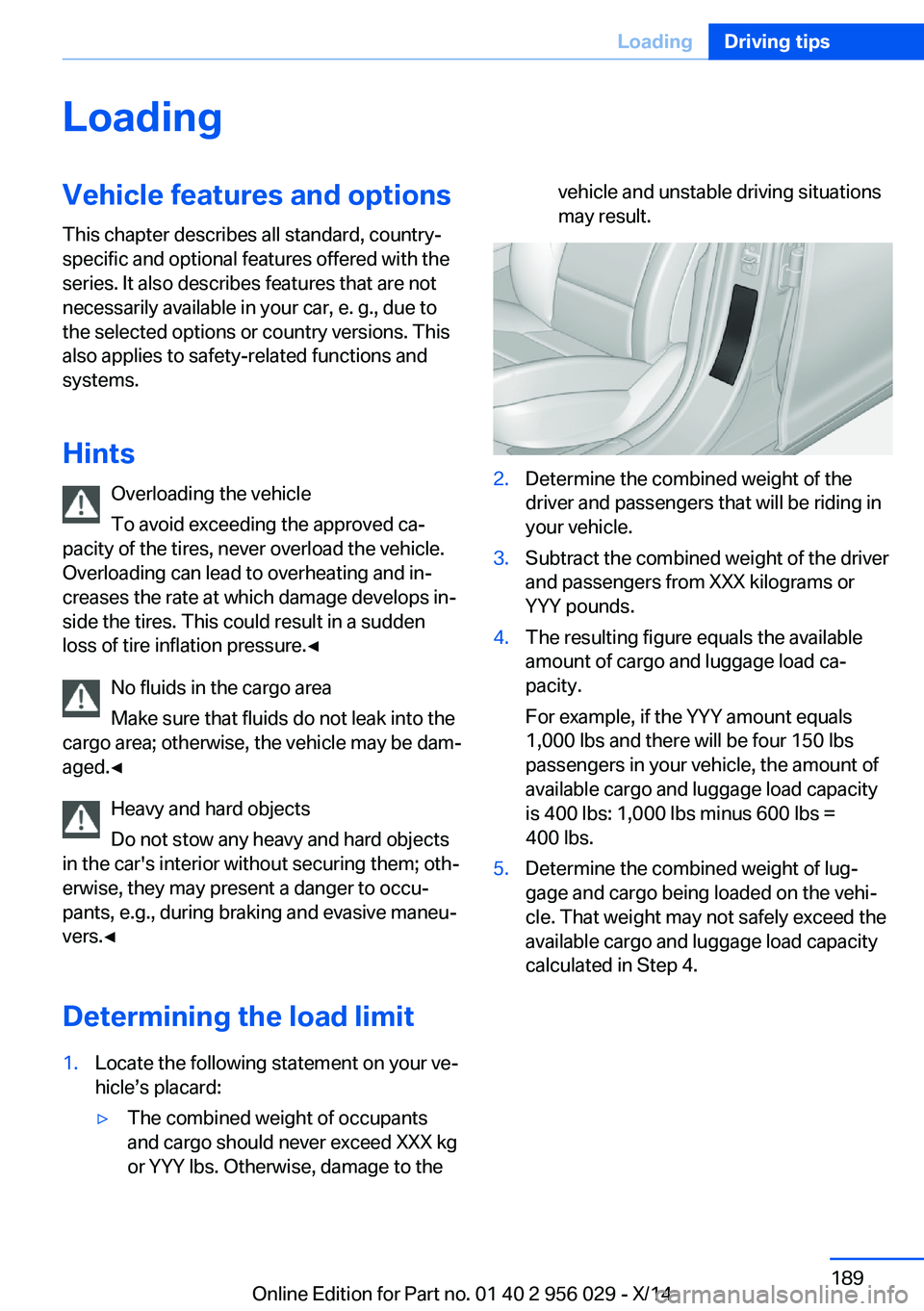
LoadingVehicle features and options
This chapter describes all standard, country-
specific and optional features offered with the
series. It also describes features that are not
necessarily available in your car, e. g., due to
the selected options or country versions. This
also applies to safety-related functions and
systems.
Hints Overloading the vehicle
To avoid exceeding the approved ca‐
pacity of the tires, never overload the vehicle.
Overloading can lead to overheating and in‐
creases the rate at which damage develops in‐
side the tires. This could result in a sudden
loss of tire inflation pressure.◀
No fluids in the cargo area
Make sure that fluids do not leak into the
cargo area; otherwise, the vehicle may be dam‐
aged.◀
Heavy and hard objects
Do not stow any heavy and hard objects
in the car's interior without securing them; oth‐
erwise, they may present a danger to occu‐
pants, e.g., during braking and evasive maneu‐
vers.◀
Determining the load limit1.Locate the following statement on your ve‐
hicle’s placard:▷The combined weight of occupants
and cargo should never exceed XXX kg
or YYY lbs. Otherwise, damage to thevehicle and unstable driving situations
may result.2.Determine the combined weight of the
driver and passengers that will be riding in
your vehicle.3.Subtract the combined weight of the driver
and passengers from XXX kilograms or
YYY pounds.4.The resulting figure equals the available
amount of cargo and luggage load ca‐
pacity.
For example, if the YYY amount equals
1,000 lbs and there will be four 150 lbs
passengers in your vehicle, the amount of
available cargo and luggage load capacity
is 400 lbs: 1,000 lbs minus 600 lbs =
400 lbs.5.Determine the combined weight of lug‐
gage and cargo being loaded on the vehi‐
cle. That weight may not safely exceed the
available cargo and luggage load capacity
calculated in Step 4.Seite 189LoadingDriving tips189
Online Edition for Part no. 01 40 2 956 029 - X/14
Page 196 of 265
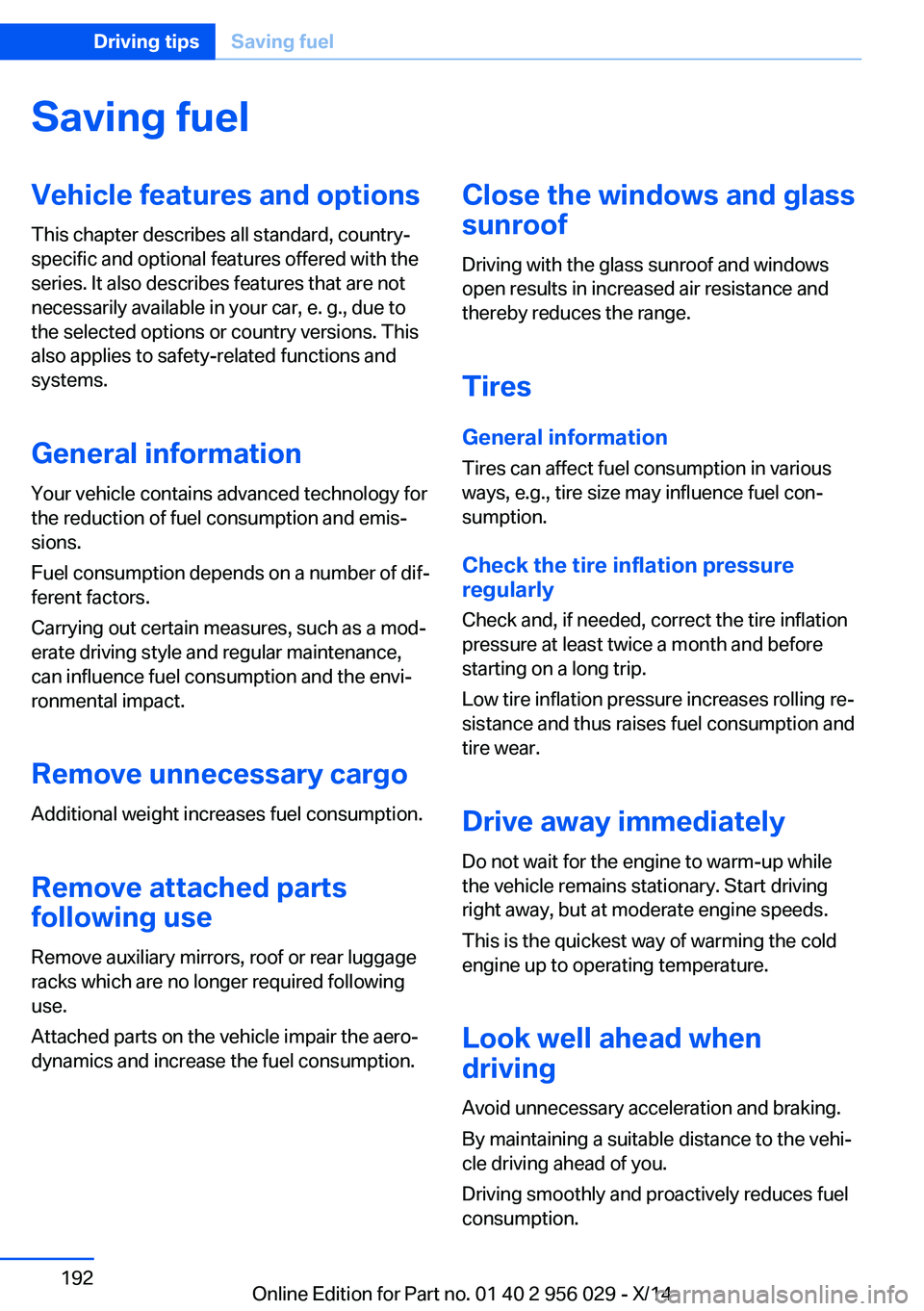
Saving fuelVehicle features and optionsThis chapter describes all standard, country-
specific and optional features offered with the
series. It also describes features that are not
necessarily available in your car, e. g., due to
the selected options or country versions. This
also applies to safety-related functions and
systems.
General information
Your vehicle contains advanced technology for
the reduction of fuel consumption and emis‐
sions.
Fuel consumption depends on a number of dif‐
ferent factors.
Carrying out certain measures, such as a mod‐
erate driving style and regular maintenance,
can influence fuel consumption and the envi‐
ronmental impact.
Remove unnecessary cargoAdditional weight increases fuel consumption.
Remove attached parts
following use
Remove auxiliary mirrors, roof or rear luggage
racks which are no longer required following
use.
Attached parts on the vehicle impair the aero‐
dynamics and increase the fuel consumption.Close the windows and glass
sunroof
Driving with the glass sunroof and windows
open results in increased air resistance and
thereby reduces the range.
Tires
General information Tires can affect fuel consumption in various
ways, e.g., tire size may influence fuel con‐
sumption.
Check the tire inflation pressure
regularly
Check and, if needed, correct the tire inflation
pressure at least twice a month and before
starting on a long trip.
Low tire inflation pressure increases rolling re‐
sistance and thus raises fuel consumption and
tire wear.
Drive away immediately
Do not wait for the engine to warm-up while
the vehicle remains stationary. Start driving
right away, but at moderate engine speeds.
This is the quickest way of warming the cold
engine up to operating temperature.
Look well ahead when
driving
Avoid unnecessary acceleration and braking.
By maintaining a suitable distance to the vehi‐
cle driving ahead of you.
Driving smoothly and proactively reduces fuel
consumption.Seite 192Driving tipsSaving fuel192
Online Edition for Part no. 01 40 2 956 029 - X/14
Page 211 of 265
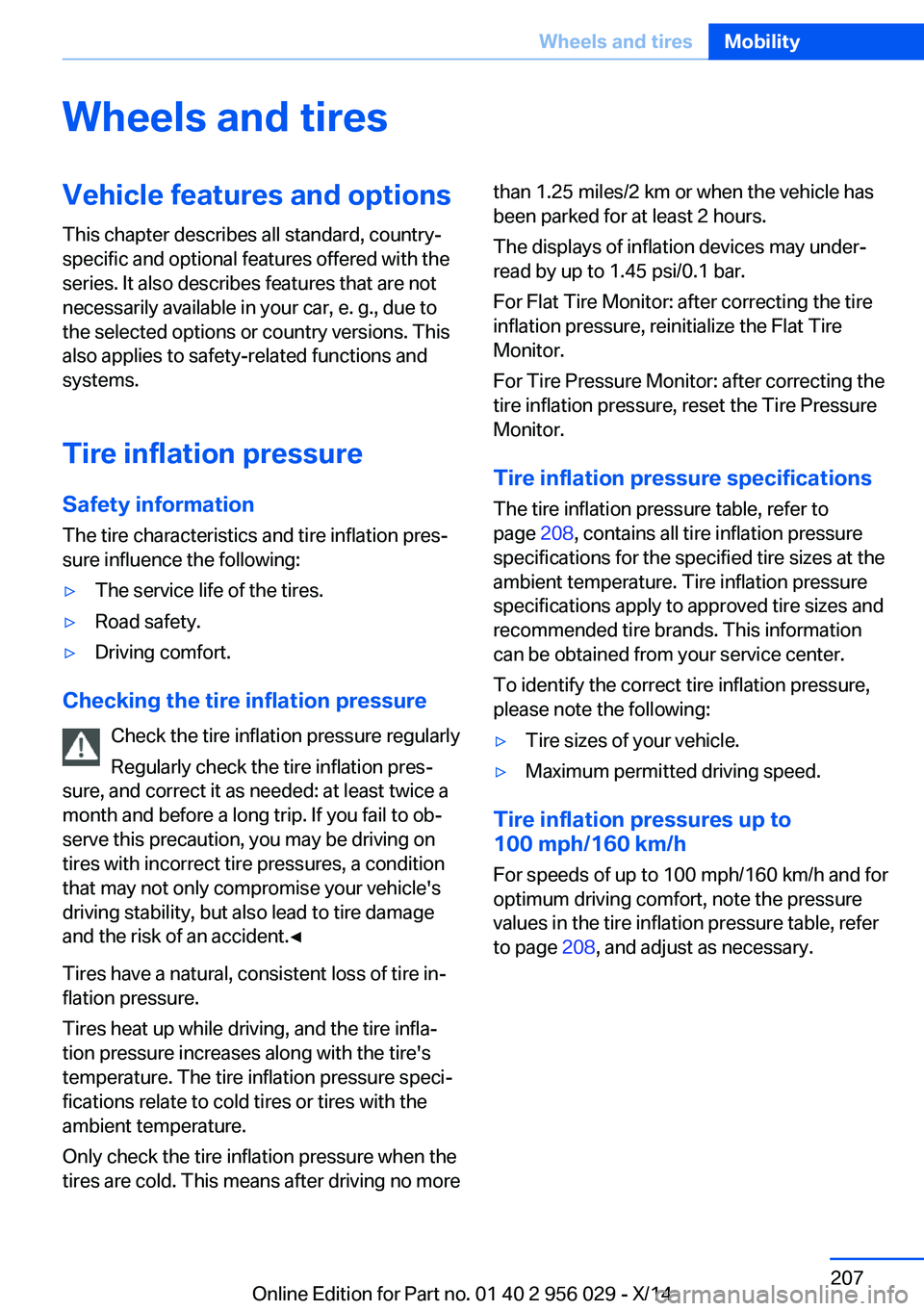
Wheels and tiresVehicle features and options
This chapter describes all standard, country-
specific and optional features offered with the
series. It also describes features that are not
necessarily available in your car, e. g., due to
the selected options or country versions. This
also applies to safety-related functions and
systems.
Tire inflation pressure
Safety information
The tire characteristics and tire inflation pres‐
sure influence the following:▷The service life of the tires.▷Road safety.▷Driving comfort.
Checking the tire inflation pressure
Check the tire inflation pressure regularly
Regularly check the tire inflation pres‐
sure, and correct it as needed: at least twice a
month and before a long trip. If you fail to ob‐
serve this precaution, you may be driving on
tires with incorrect tire pressures, a condition
that may not only compromise your vehicle's
driving stability, but also lead to tire damage
and the risk of an accident.◀
Tires have a natural, consistent loss of tire in‐
flation pressure.
Tires heat up while driving, and the tire infla‐
tion pressure increases along with the tire's
temperature. The tire inflation pressure speci‐
fications relate to cold tires or tires with the
ambient temperature.
Only check the tire inflation pressure when the
tires are cold. This means after driving no more
than 1.25 miles/2 km or when the vehicle has
been parked for at least 2 hours.
The displays of inflation devices may under-
read by up to 1.45 psi/0.1 bar.
For Flat Tire Monitor: after correcting the tire
inflation pressure, reinitialize the Flat Tire
Monitor.
For Tire Pressure Monitor: after correcting the
tire inflation pressure, reset the Tire Pressure
Monitor.
Tire inflation pressure specifications
The tire inflation pressure table, refer to
page 208, contains all tire inflation pressure
specifications for the specified tire sizes at the
ambient temperature. Tire inflation pressure
specifications apply to approved tire sizes and
recommended tire brands. This information
can be obtained from your service center.
To identify the correct tire inflation pressure,
please note the following:▷Tire sizes of your vehicle.▷Maximum permitted driving speed.
Tire inflation pressures up to
100 mph/160 km/h
For speeds of up to 100 mph/160 km/h and for
optimum driving comfort, note the pressure
values in the tire inflation pressure table, refer
to page 208, and adjust as necessary.
Seite 207Wheels and tiresMobility207
Online Edition for Part no. 01 40 2 956 029 - X/14
Page 212 of 265
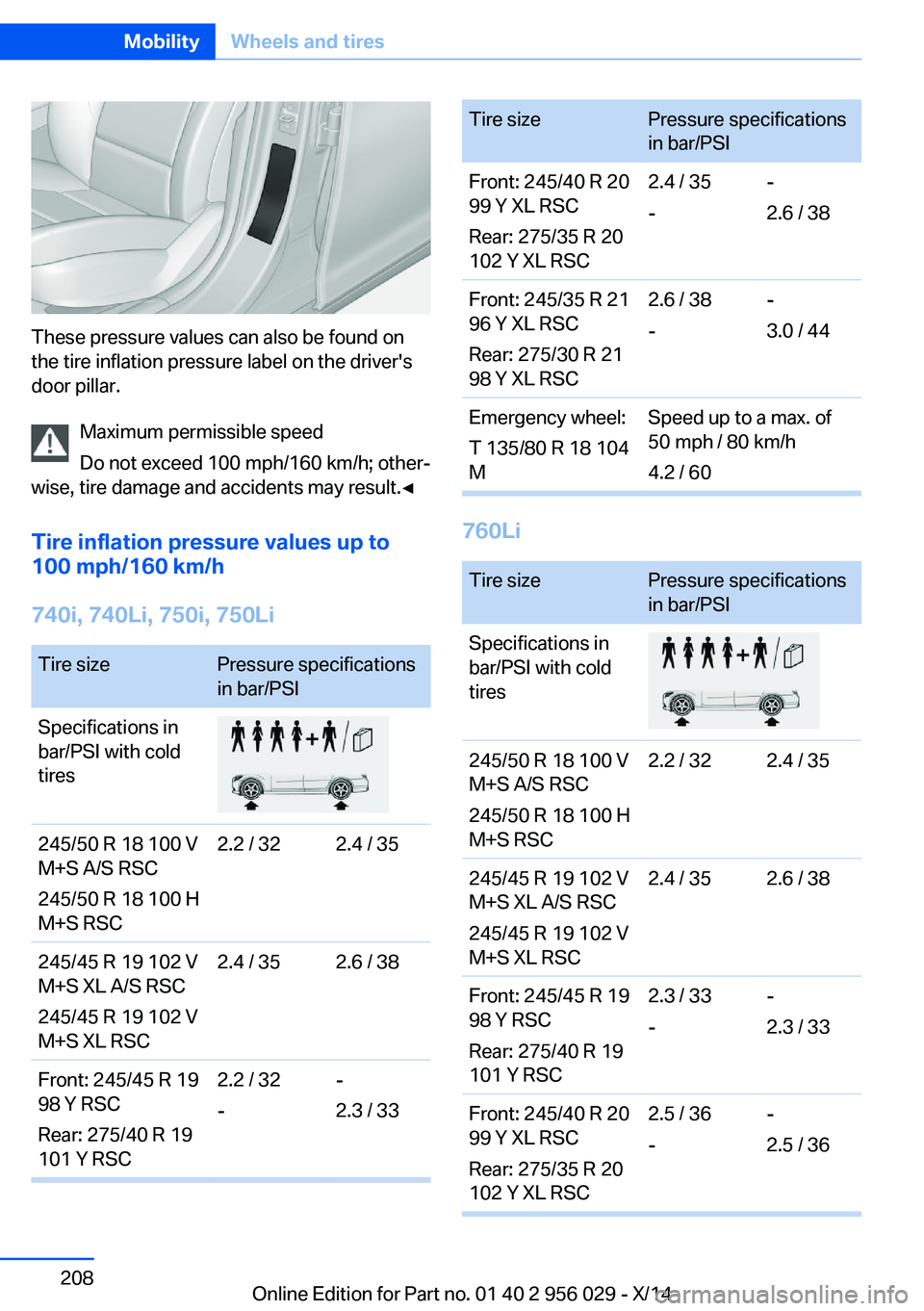
These pressure values can also be found on
the tire inflation pressure label on the driver's
door pillar.
Maximum permissible speed
Do not exceed 100 mph/160 km/h; other‐
wise, tire damage and accidents may result.◀
Tire inflation pressure values up to
100 mph/160 km/h
740i, 740Li, 750i, 750Li
Tire sizePressure specifications
in bar/PSISpecifications in
bar/PSI with cold
tires245/50 R 18 100 V
M+S A/S RSC
245/50 R 18 100 H
M+S RSC2.2 / 322.4 / 35245/45 R 19 102 V
M+S XL A/S RSC
245/45 R 19 102 V
M+S XL RSC2.4 / 352.6 / 38Front: 245/45 R 19
98 Y RSC
Rear: 275/40 R 19
101 Y RSC2.2 / 32
--
2.3 / 33Tire sizePressure specifications
in bar/PSIFront: 245/40 R 20
99 Y XL RSC
Rear: 275/35 R 20
102 Y XL RSC2.4 / 35
--
2.6 / 38Front: 245/35 R 21
96 Y XL RSC
Rear: 275/30 R 21
98 Y XL RSC2.6 / 38
--
3.0 / 44Emergency wheel:
T 135/80 R 18 104
MSpeed up to a max. of
50 mph / 80 km/h
4.2 / 60
760Li
Tire sizePressure specifications
in bar/PSISpecifications in
bar/PSI with cold
tires245/50 R 18 100 V
M+S A/S RSC
245/50 R 18 100 H
M+S RSC2.2 / 322.4 / 35245/45 R 19 102 V
M+S XL A/S RSC
245/45 R 19 102 V
M+S XL RSC2.4 / 352.6 / 38Front: 245/45 R 19
98 Y RSC
Rear: 275/40 R 19
101 Y RSC2.3 / 33
--
2.3 / 33Front: 245/40 R 20
99 Y XL RSC
Rear: 275/35 R 20
102 Y XL RSC2.5 / 36
--
2.5 / 36Seite 208MobilityWheels and tires208
Online Edition for Part no. 01 40 2 956 029 - X/14
Page 213 of 265
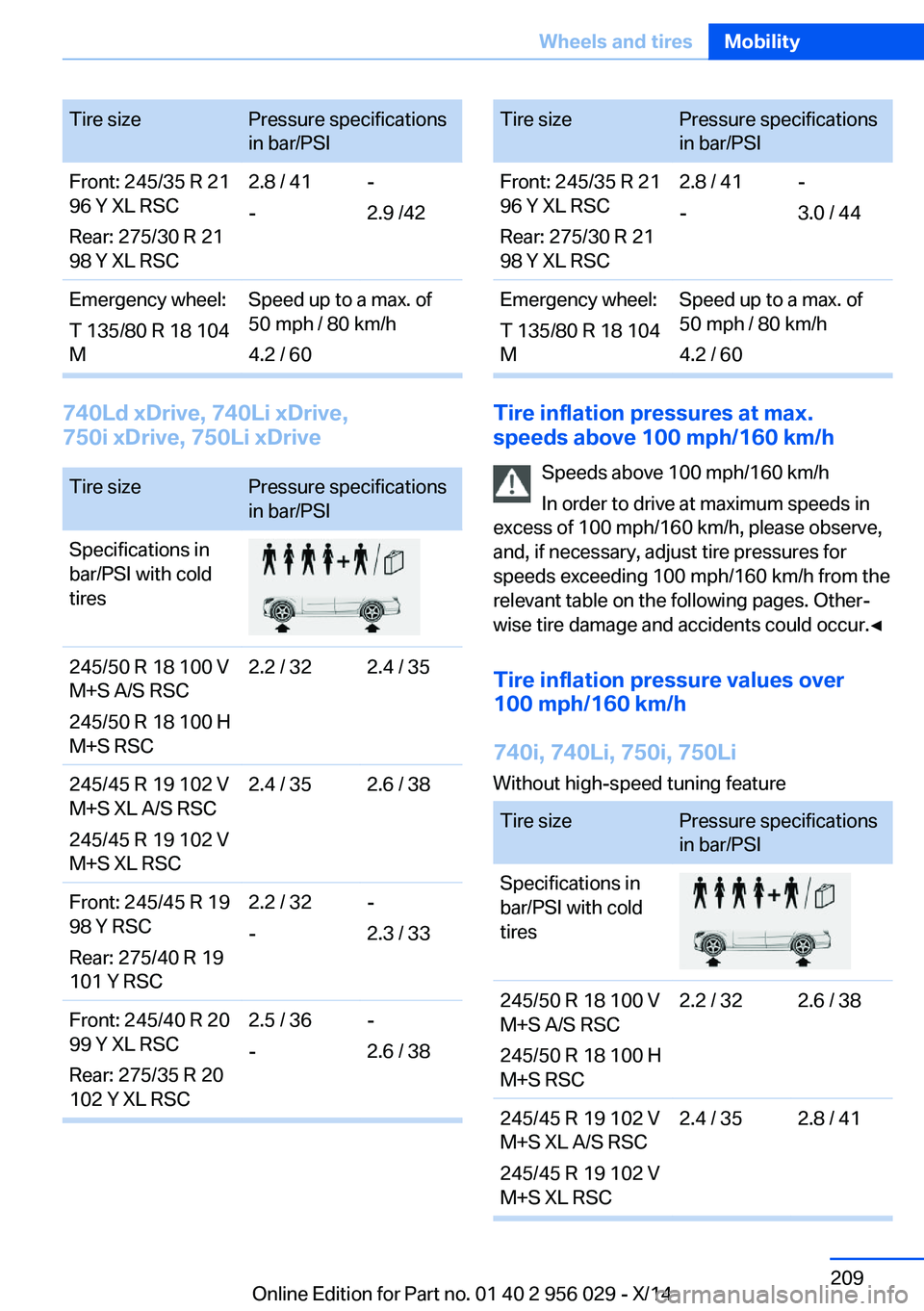
Tire sizePressure specifications
in bar/PSIFront: 245/35 R 21
96 Y XL RSC
Rear: 275/30 R 21
98 Y XL RSC2.8 / 41
--
2.9 /42Emergency wheel:
T 135/80 R 18 104
MSpeed up to a max. of
50 mph / 80 km/h
4.2 / 60
740Ld xDrive, 740Li xDrive,
750i xDrive, 750Li xDrive
Tire sizePressure specifications
in bar/PSISpecifications in
bar/PSI with cold
tires245/50 R 18 100 V
M+S A/S RSC
245/50 R 18 100 H
M+S RSC2.2 / 322.4 / 35245/45 R 19 102 V
M+S XL A/S RSC
245/45 R 19 102 V
M+S XL RSC2.4 / 352.6 / 38Front: 245/45 R 19
98 Y RSC
Rear: 275/40 R 19
101 Y RSC2.2 / 32
--
2.3 / 33Front: 245/40 R 20
99 Y XL RSC
Rear: 275/35 R 20
102 Y XL RSC2.5 / 36
--
2.6 / 38Tire sizePressure specifications
in bar/PSIFront: 245/35 R 21
96 Y XL RSC
Rear: 275/30 R 21
98 Y XL RSC2.8 / 41
--
3.0 / 44Emergency wheel:
T 135/80 R 18 104
MSpeed up to a max. of
50 mph / 80 km/h
4.2 / 60
Tire inflation pressures at max.
speeds above 100 mph/160 km/h
Speeds above 100 mph/160 km/h
In order to drive at maximum speeds in
excess of 100 mph/160 km/h, please observe,
and, if necessary, adjust tire pressures for
speeds exceeding 100 mph/160 km/h from the
relevant table on the following pages. Other‐
wise tire damage and accidents could occur.◀
Tire inflation pressure values over
100 mph/160 km/h
740i, 740Li, 750i, 750Li Without high-speed tuning feature
Tire sizePressure specifications
in bar/PSISpecifications in
bar/PSI with cold
tires245/50 R 18 100 V
M+S A/S RSC
245/50 R 18 100 H
M+S RSC2.2 / 322.6 / 38245/45 R 19 102 V
M+S XL A/S RSC
245/45 R 19 102 V
M+S XL RSC2.4 / 352.8 / 41Seite 209Wheels and tiresMobility209
Online Edition for Part no. 01 40 2 956 029 - X/14
Page 220 of 265
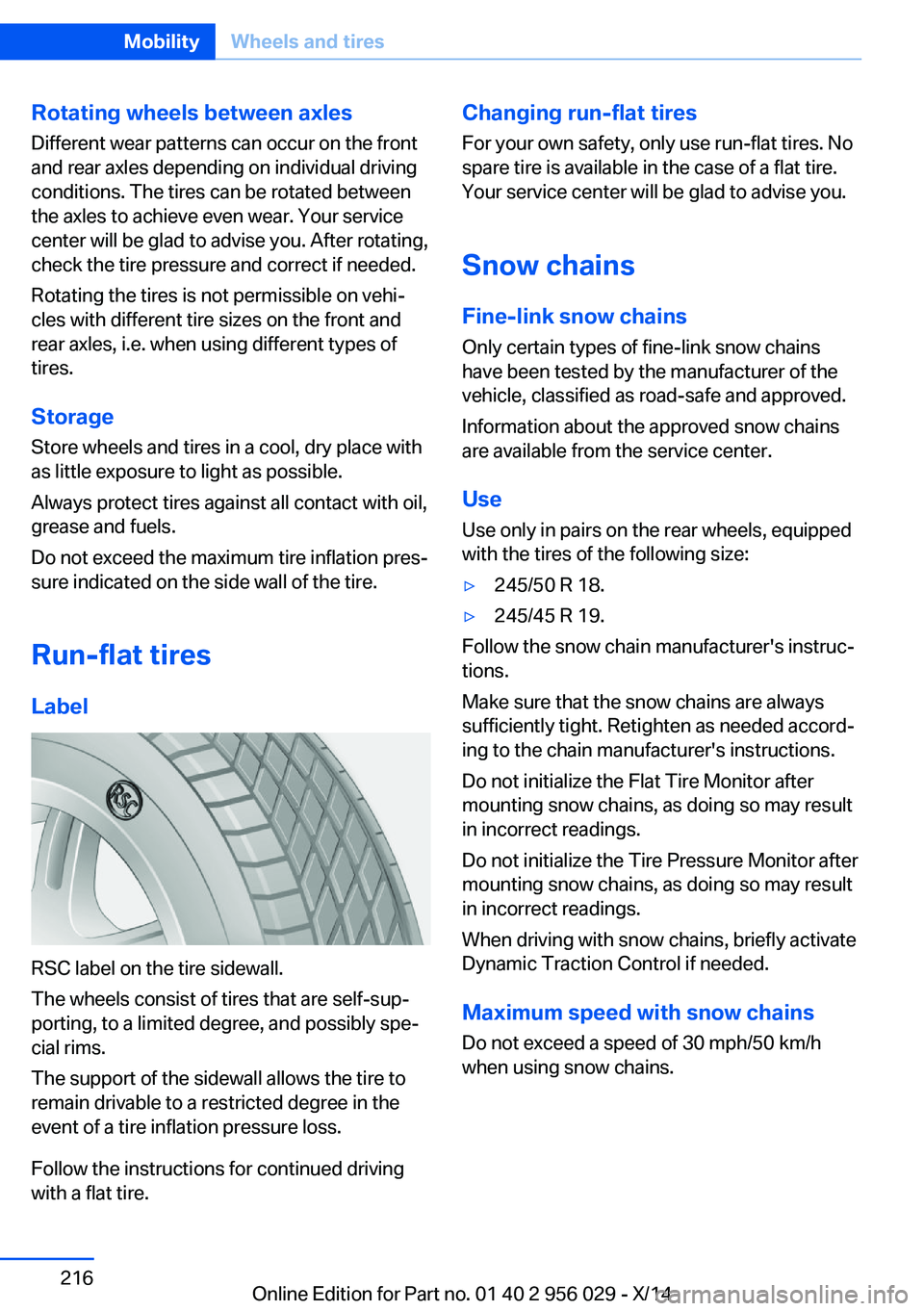
Rotating wheels between axlesDifferent wear patterns can occur on the frontand rear axles depending on individual driving
conditions. The tires can be rotated between
the axles to achieve even wear. Your service
center will be glad to advise you. After rotating,
check the tire pressure and correct if needed.
Rotating the tires is not permissible on vehi‐
cles with different tire sizes on the front and
rear axles, i.e. when using different types of
tires.
Storage
Store wheels and tires in a cool, dry place with
as little exposure to light as possible.
Always protect tires against all contact with oil,
grease and fuels.
Do not exceed the maximum tire inflation pres‐
sure indicated on the side wall of the tire.
Run-flat tires
Label
RSC label on the tire sidewall.
The wheels consist of tires that are self-sup‐
porting, to a limited degree, and possibly spe‐
cial rims.
The support of the sidewall allows the tire to
remain drivable to a restricted degree in the
event of a tire inflation pressure loss.
Follow the instructions for continued driving
with a flat tire.
Changing run-flat tires
For your own safety, only use run-flat tires. No
spare tire is available in the case of a flat tire.
Your service center will be glad to advise you.
Snow chains
Fine-link snow chains
Only certain types of fine-link snow chains
have been tested by the manufacturer of the
vehicle, classified as road-safe and approved.
Information about the approved snow chains
are available from the service center.
Use
Use only in pairs on the rear wheels, equipped
with the tires of the following size:▷245/50 R 18.▷245/45 R 19.
Follow the snow chain manufacturer's instruc‐
tions.
Make sure that the snow chains are always
sufficiently tight. Retighten as needed accord‐
ing to the chain manufacturer's instructions.
Do not initialize the Flat Tire Monitor after
mounting snow chains, as doing so may result
in incorrect readings.
Do not initialize the Tire Pressure Monitor after
mounting snow chains, as doing so may result
in incorrect readings.
When driving with snow chains, briefly activate
Dynamic Traction Control if needed.
Maximum speed with snow chains Do not exceed a speed of 30 mph/50 km/hwhen using snow chains.
Seite 216MobilityWheels and tires216
Online Edition for Part no. 01 40 2 956 029 - X/14
Page 258 of 265

Gear change, Steptronictransmission 84
Gear shift indicator 97
General driving notes 186
Gentleman function 56
Glare shield 174
Glass sunroof, powered 51
Glove compartment 180
Gross vehicle weight, ap‐ proved 247
H
Handbrake, refer to Parking brake 76
Hand-held transmitter, alter‐ nating code 173
Hazard warning flashers 234
HDC Hill Descent Con‐ trol 138
Head airbags 110
Headlight control, auto‐ matic 106
Headlight courtesy delay fea‐ ture 105
Headlight courtesy delay fea‐ ture via remote control 38
Headlight flasher 81
Headlight glass 228
Headlights, care 240
Headlight washer system 81
Head restraints 54
Head restraints, front 61
Head restraints, rear 62
Head-up Display 103
Head-up Display, care 242
Heavy cargo, stowing 190
Height, vehicle 246
High-beam Assistant 107
High beams 81
High beams/low beams, refer to High-beam Assistant 107
Hill Descent Control HDC 138
Hills 188 Hill start assistant, refer to
Drive-off assistant 136
Hints 6
Holder for beverages 182
Hood 218
Horn 14
Hotel function, trunk lid 43
Hot exhaust system 186
HUD Head-up Display 103
Hydroplaning 187
I Ice warning, see External temperature warning 95
Icy roads, see External tem‐ perature warning 95
Identification marks, tires 212
Identification number, see ve‐ hicle identification num‐
ber 9
iDrive 18
Ignition key, refer to Remote control 34
Ignition off 73
Ignition on 73
Indication of a flat tire 114 , 116
Indicator and alarm lamps, see Check Control 90
Indicator lamp, see Check Control 90
Individual air distribution 166
Individual settings, refer to Personal Profile 35
Inflation pressure, tires 207
Inflation pressure warning FTM, tires 113
Info display, refer to Com‐ puter 99
Initialization, Integral Active Steering 140
Initialize, Tire Pressure Moni‐ tor TPM 116
Initializing, Flat Tire Monitor FTM 113 Instrument cluster 87
Instrument cluster, electronic displays 87
Instrument display, multifunc‐ tional 88
Instrument lighting 108
Integral Active Steering 140
Integrated key 34
Integrated Owner's Manual in the vehicle 29
Intelligent Emergency Re‐ quest 234
Intelligent Safety 118
Intensity, AUTO pro‐ gram 166
Interior equipment 172
Interior lights 108
Interior lights via remote con‐ trol 38
Interior motion sensor 48
Interior rearview mirror, auto‐ matic dimming feature 67
Interior rearview mirror, man‐ ually dimmable 67
Interval display, service re‐ quirements 96
J Jacking points for the vehicle jack 231
Joystick, Steptronic transmis‐ sion 84
Jump-starting 235
K
Key/remote control 34
Keyless Go, refer to Comfort Access 43
Key Memory, refer to Per‐ sonal Profile 35
Kickdown, Steptronic trans‐ mission 84
Knee airbag 110 Seite 254ReferenceEverything from A to Z254
Online Edition for Part no. 01 40 2 956 029 - X/14
Page 262 of 265

Socket, OBD Onboard Diag‐nostics 225
Soot particulate filter 187
SOS button 234
Spare fuse 233
Speaker lighting 109
Specified engine oil types 222
Speed, average 100
Speed limit detection, com‐ puter 100
Speed limiter, display 97
Speed Limit Information 97
Speed warning 101
Split screen 23
SPORT+ - program, Dynamic Driving Control 142
Sport displays, torque dis‐ play, performance dis‐
play 101
SPORT program, driving dy‐ namics 142
Sport program, transmis‐ sion 85
Stability control systems 136
Start/stop, automatic func‐ tion 75
Start/Stop button 73
Start function during malfunc‐ tion 35
Starting the engine 74
Status control display, tires 115
Status information, iDrive 22
Status of Owner's Manual 6
Steering, Integral Active Steering 140
Steering wheel, adjusting 67
Steering wheel heating 68
Steering wheel memory 64
Steptronic Sport transmis‐ sion 86
Steptronic transmission 84
Stopping the engine 74
Storage compartments 180 Storage compartments, loca‐
tions 180
Storage, tires 216
Storing the vehicle 242
Summer tires, tread 214
Sun visor 174
Supplementary text mes‐ sage 93
Surround View 155
Suspension settings 141
Switch for Dynamic Driving Control 141
Switch-on times, parked-car ventilation 171
Switch, refer to Cockpit 14
Symbols 6
Symbols in the status field 22
SYNC program, automatic cli‐ mate control 167
T Tachometer 94
Tail and brake lights 230
Tail lights 230
Tail lights, bulb replace‐ ment 230
Technical changes, refer to Safety 7
Technical data 246
Telephone, see user's manual for Navigation, Entertain‐
ment and Communication
Temperature, automatic cli‐ mate control 166
Temperature display for ex‐ ternal temperature 95
Temperature, engine oil 94
Terminal, starting aid 236
Text message, supplemen‐ tary 93
Theft alarm system, refer to Alarm system 47
Theft protection, lug bolts 231 Thermal camera, see Night
Vision 127
Thigh support 55
Tilt alarm sensor 48
Time of arrival 100
Tire damage 214
Tire identification marks 212
Tire inflation pressure 207
Tire inflation pressure moni‐ tor, refer to FTM 113
Tire Pressure Monitor TPM 115
Tires, changing 214
Tires, everything on wheels and tires 207
Tires, run-flat tires 216
Tire tread 214
Tone, see user's manual for Navigation, Entertainment
and Communication
Tool 227
Top View 159
Total vehicle weight 247
Touchpad 21
Tow fitting 238
Towing 237
Tow lug, see tow fitting 238
Tow-starting 237
TPM Tire Pressure Moni‐ tor 115
Traction control 137
TRACTION, driving dynam‐ ics 137
TRACTION program, Dy‐ namic Driving Control 142
Transmission lock, electronic unlocking 86
Transmission, see Steptronic transmission 84
Transporting children safely 69
Tread, tires 214
Trip computer 100
Triple turn signal activa‐ tion 80
Trip odometer 95 Seite 258ReferenceEverything from A to Z258
Online Edition for Part no. 01 40 2 956 029 - X/14